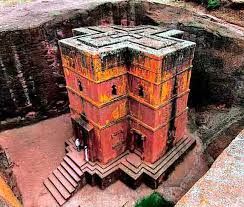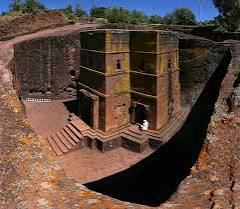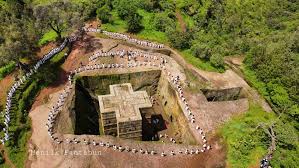A Hidden Wonder in the Ethiopian Highlands.
In the rugged highlands of Ethiopia, where towering plateaus rise like ancient fortresses, lies one of the world’s most breathtaking spiritual and architectural wonders—the rock-hewn churches of Lalibela. These 11 magnificent churches were not built in the traditional sense. Instead, they were chiseled directly into the volcanic rock, sculpted from single monolithic blocks without the use of bricks, mortar, or timber. How were they created? Who carved them? And why attempt such an impossible feat? These questions have intrigued historians and travelers for centuries. But for the Ethiopian Orthodox faithful, the answer is simple: the churches of Lalibela were built with the help of angels.

A King’s Vision: The Birth of Lalibela.
To understand the significance of Lalibela, we must journey back to the 12th century. By this time, Ethiopia had been a Christian kingdom for nearly 800 years, tracing its faith back to the 4th century. King Gebre Meskel Lalibela of the Zagwe Dynasty (c. 1181–1221 AD) is said to have traveled 1,600 miles to Jerusalem as a young man. However, by the time of his return, the Holy City had fallen under Islamic rule, making pilgrimages dangerous for Ethiopian Christians. Determined to provide his people with a sacred refuge, he envisioned a “New Jerusalem” in Ethiopia—a city of churches hewn from the living rock, mirroring the biblical city itself. According to legend, King Lalibela did not work alone. It is said that angels descended each night to continue the work, completing what human hands could not.
The Miracle of Lalibela’s Construction.
Unlike conventional buildings, where stones are cut and stacked, the churches of Lalibela were excavated entirely from massive rock formations. 1. **The process began with deep trenches**, isolating large blocks of stone. 2. **From these blocks, master artisans chiseled doorways, windows, columns, and ceilings**—a painstaking effort requiring extraordinary precision. 3. **Intricate carvings and vaulted ceilings emerged**, mimicking traditional Ethiopian wooden churches, despite being sculpted from solid rock. Many chambers were carved in near-total darkness, with workers relying only on their sense of touch and candlelight. The craftsmanship is breathtaking, and what makes it even more astonishing is the claim that all 11 churches were completed in just 24 years—a feat that seems almost impossible by human hands alone.

A Holy City: The Churches of Lalibela.
The churches of Lalibela are divided into three distinct groups, symbolizing different aspects of Christian faith:
The Northern Group :
Bet Medhane Alem – The largest rock-hewn church in the world, resembling a grand basilica.
Bet Maryam – The first church carved, dedicated to the Virgin Mary.
Bet Meskel, Bet Danaghel, and Bet Mikael – Smaller but intricately detailed churches.
The Eastern Group :
Bet Amanuel – Believed to be the royal chapel.
Bet Abba Libano – Said to have been built overnight by Queen Masqal Kibra with divine assistance. –
Bet Gabriel-Rufael – Possibly a former royal palace.
The Western Group – Bet Giyorgis (Church of Saint George)– The most famous and perfectly preserved church, carved in the shape of a Greek cross. A small river runs through the complex, which King Lalibela named the **River Jordan**, further reinforcing the biblical symbolism.

A Sacred Pilgrimage.
For centuries, Ethiopian Orthodox Christians have made the long and often grueling pilgrimage to Lalibela. Every year, especially during “Genna (Ethiopian Christmas), nearly 200,000 pilgrims descend upon the town, many traveling for weeks or even months on foot. Dressed in flowing white robes, they walk barefoot along ancient paths, fasting and praying, carrying only their faith. Upon arrival, they descend into the churches, where priests chant sacred hymns, and the echoes of prayers fill the carved stone walls. One pilgrim, Gatier Ababao, who walked nearly 100 miles with his daughter, explained why he endured the difficult journey: > **”God can hear our prayers anywhere, but coming here shows our devotion.”
For the faithful, Lalibela is more than a place—it is a spiritual experience, a direct link to the divine.
Lalibela’s Connection to the Ark of the Covenant.
The significance of Lalibela goes beyond its churches. According to Ethiopian Orthodox tradition, the Ark of the Covenant—the sacred chest containing the Ten Commandments—was brought to Ethiopia by Menelik I, the son of King Solomon and the Queen of Sheba. It is believed to rest today in the **Church of Our Lady Mary of Zion in Axum**, guarded by a single monk who never leaves its presence. This deep biblical connection further strengthens Lalibela’s status as one of the most sacred sites in Christianity.
Preserving the Churches for Future Generations.
While Lalibela’s churches have stood for over 800 years, they are not immune to the forces of time. Erosion, rain, and temperature fluctuations have weakened sections of the stone. Some areas are so fragile that they crumble at a mere touch. To combat this, the World Monuments Fund has partnered with local priests to develop preservation techniques. Conservationists must work carefully—any restoration effort must respect the sacred nature of the churches. In one case, when a restoration team needed to drill into a church wall, local priests insisted that all stone dust be collected, as they believed it to be holy. A controversial preservation effort involved installing large metal roofs over the churches to shield them from rain. However, these “gas station roofs,” as locals call them, altered the natural aging process of the stone, creating new conservation challenges. Conservationists now focus on sustainable methods to ensure that these rock-hewn sanctuaries stand for another thousand years.

A Legacy Set in Stone.
The churches of Lalibela remain one of the greatest architectural and spiritual wonders of the world. Whether built by human hands or divine intervention, they stand as a testament to faith, perseverance, and artistic brilliance. Perhaps the answer to why these churches were built lies not in history, but in faith itself. The book of Isaiah offers a verse that seems to reflect Lalibela’s true meaning: > **”Look to the rock from which you were cut, and to the quarry from which you were hewn.”** *(Isaiah 51:1)* In the presence of a miracle, faith is never washed away.
Lalibela is more than a historic site—it is a place of deep spiritual significance, a pilgrimage destination, and a testament to human ingenuity. Whether you are a history enthusiast, an adventurer, or a seeker of divine mysteries, Lalibela offers an experience like no other. If you ever have the chance to visit, prepare to walk where saints and angels are said to have tread, and witness one of the most awe-inspiring wonders of the ancient world.
If you’ve been to Lalibela or have a story about this sacred place, share your thoughts in the comments below! Let’s keep the history and wonder of Lalibela alive.


I love this article. Im familiar with this church from my world history classes.
Glad you liked it, visit more, the articles will follow 🙂